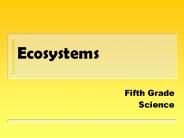Nonliving PowerPoint PPT Presentations
All Time
Recommended
Title: Living and Non-living Author: User Last modified by: User Created Date: 12/9/2005 3:37:56 PM Document presentation format: On-screen Show Company
| PowerPoint PPT presentation | free to download
Living vs. Nonliving things Science Grade 8 Living Things Living things are made of cells. Living things obtain and use energy. Living things grow and develop.
| PowerPoint PPT presentation | free to view
Living or Nonliving? Pasteur s Experiment 1 2 3 Francesco Redi s Experiment 1.) What is the theory of biogenesis? States that living things come only from other ...
| PowerPoint PPT presentation | free to view
What are Nonliving Parts of Ecosystems? By Mr. Bales Purpose The purpose of this lesson is to observe the nonliving parts of a model ecosystem. Science Standard 3.a.
| PowerPoint PPT presentation | free to view
Particular environment and all the living things supported by it ... can twirl their way towards something yummy or twirl their way away from something bad. ...
| PowerPoint PPT presentation | free to view
Classify the objects on the following s. Oak Tree. Kitten. Umbrella. Bird. Bird House. Toy Cat. Lizard, Frog, and Snake. Rocks. Children ...
| PowerPoint PPT presentation | free to view
Do now: List some examples of living things. What do all of these living things have in common? Vocabulary: living things, non living things, metabolism, synthesis ...
| PowerPoint PPT presentation | free to view
... different replication cycles of bacteriophages; the lytic cycle and lysogenic cycle. Bacteriophage. Viruses that infect bacteria. Lytic Cycle ...
| PowerPoint PPT presentation | free to view
Title: PowerPoint Presentation Author: McDougal Littell Last modified by: mike Created Date: 9/14/2006 4:17:10 PM Document presentation format: On-screen Show (4:3)
| PowerPoint PPT presentation | free to download
KEY CONCEPT Every ecosystem includes both living (biotic) and nonliving (abiotic) factors. Biotic factors are living things. plants animals fungi bacteria plants ...
| PowerPoint PPT presentation | free to view
The study of the interactions between organisms and the living and nonliving components of their environment.
| PowerPoint PPT presentation | free to download
Non-living things are all the things that are dead, or not alive. Examples: cars, toys, dolls, computers, books, and chairs. 9/2/09. Living and Non-Living Things ...
| PowerPoint PPT presentation | free to view
Ecology- is the scientific study of organisms and the interactions with their environment (living and nonliving things)
| PowerPoint PPT presentation | free to view
I- Living Things Carry Out Life Processes A- Organisms, (any living thing) share certain characteristics that set them apart from nonliving things.
| PowerPoint PPT presentation | free to view
Soil contains different combination of sand clay and humus (decaying matter) ... Carbon is important part of soil Humus, and is found in the atmosphere as CO2 ...
| PowerPoint PPT presentation | free to view
Our Living and Nonliving Book. by Chelsea and Drew. A mailbox is a nonliving thing. ... Scissors are a nonliving thing. This plant is also a living thing. ...
| PowerPoint PPT presentation | free to view
Medium to promote the growth of plants and animals while ... Increased chemical and pesticide use. Plant disease problems. Reduced biological diversity ...
| PowerPoint PPT presentation | free to view
A Nonliving and Living Book. by Marlon, Bryce, Caldrick, and Kelli. A doorstop is a nonliving thing. ... A trash can is a nonliving thing. Grass is a living ...
| PowerPoint PPT presentation | free to view
Let s Practice Tell if the object is living or nonliving. Nonliving Living Living Nonliving Living Living Living Let s learn about the 7 characteristics of life.
| PowerPoint PPT presentation | free to download
Parts of Ecosystems What are nonliving parts of ecosystems? What are nonliving parts of ecosystems? An ecosystem is made up of all the living and nonliving things ...
| PowerPoint PPT presentation | free to view
What is an organism?-any living thing-There are 7 characteristics that distinguishes living from nonliving.
| PowerPoint PPT presentation | free to view
Viruses The nonliving Viruses Considered nonliving No cells (cell = basic unit of life) no organelles Do not carry out respiration Cannot reproduce on their own But ...
| PowerPoint PPT presentation | free to download
Biochemical Cycles- closed circles or cycles of materials from nonliving to living organisms and back to nonliving. Examples : Water, carbon, nitrogen and phosphorus
| PowerPoint PPT presentation | free to download
Viruses Characteristics of Viruses Nonliving particle made up of nucleic acid & protein Nonliving because lack some characteristics of life Cause many diseases in ...
| PowerPoint PPT presentation | free to download
Ecosystems 4th grade Science Ecosystems Ecosystems include both living and nonliving things. Nonliving things include water, rocks, air, light, and soil.
| PowerPoint PPT presentation | free to view
Ecological Relationships Important Vocabulary Biotic Factors: living things Abiotic Factors: nonliving, physical things such as: Temperature, sunlight, precipitation ...
| PowerPoint PPT presentation | free to view
The Carbon Cycle The movement of carbon through the living and nonliving parts of the biosphere. Biological processes Photosynthesis Cellular Respiration ...
| PowerPoint PPT presentation | free to view
viruses Living Nonliving Contain a single type of nucleic acid (DNA or RNA), protein coat, sometimes an envelope. Are obligatory intracellular parasites.
| PowerPoint PPT presentation | free to download
Ecosystems Have Living and Nonliving Components Abiotic Water Air Nutrients Rocks Heat Solar energy pH Biotic Living (or once living) ...
| PowerPoint PPT presentation | free to download
Communities & Biomes Biotic & Abiotic Factors Biotic = Living organisms Abiotic = Nonliving Soil,Air,Water Substrate 1.Community: Biotic factors All the Plants ...
| PowerPoint PPT presentation | free to view
What is ecology? The scientific study of interactions between organisms and their environment. Interactions can take place between living and nonliving things.
| PowerPoint PPT presentation | free to view
Composition of blood Blood transports materials through out the body inside blood vessels. Plasma Straw colored, nonliving part of blood. 90% Water Helps to regulate ...
| PowerPoint PPT presentation | free to download
Ecosystems Biogeochemical Cycles KEY CONCEPT 1 Ecosystems consist of nonliving (abiotic) and living (biotic) components. KEY CONCEPT 2 An ecosystem survives by a ...
| PowerPoint PPT presentation | free to view
Ecology Biotic vs Abiotic Factors Environment Biotic Factors Abiotic Factors living nonliving Biotic vs Abiotic Factors Biotic = living (BIO = life) Abiotic ...
| PowerPoint PPT presentation | free to download
Sedimentary Igneous Metamorphic What are minerals? Minerals are naturally occurring, nonliving substances found in Earth. They have a chemical formula, and a definite ...
| PowerPoint PPT presentation | free to view
Nature is abundant, it’s a soul for all the living and nonliving things. We must protect our nature and accept the natural beauty as it is. The natural resource is anything that people can use which comes from the natural environment. So, everyone uses Eco-friendly products and make the healthy world. Let's the future is Green with Leaftrend. For more details visit us at https://goo.gl/B2uNic
| PowerPoint PPT presentation | free to download
Epithelial Tissues Tissues Introduction a group of similar cells specialized to carry on a particular function tissue = cells + extracellular matrix nonliving ...
| PowerPoint PPT presentation | free to view
Ecosystem PowerPoint By: Christian Gomez Period 7 Science Mr. Sunesara What is an Ecosystem? All the living and nonliving things that interact in an area.
| PowerPoint PPT presentation | free to view
The Cell Membrane Overview Cell membrane separates living cell from nonliving surroundings thin barrier = 8nm thick Controls traffic in & out of the cell selectively ...
| PowerPoint PPT presentation | free to view
Interactions Among Living Things I. Living Things and Their Environment All of the living (biotic) and nonliving (abiotic) things in an environment are interconnected.
| PowerPoint PPT presentation | free to download
Guess the Covered Word Chapter 3 environment everything that surrounds a living thing Living & nonliving parts that interact in an environment ecosystem habitat place ...
| PowerPoint PPT presentation | free to download
KEY CONCEPT Every ecosystem includes both living and nonliving factors. An ecosystem includes both biotic and abiotic factors. Biotic factors are living things ...
| PowerPoint PPT presentation | free to download
Principles of Ecology Ecology study of relationships between living and nonliving parts of the world Ernst Haeckel (1866) first to use the word to name the ...
| PowerPoint PPT presentation | free to view
Ecosystem Recycling Matter must be recycled and reused Substances pass between living and nonliving worlds Water, carbon, nitrogen, calcium, phosphorus Biogeochemical ...
| PowerPoint PPT presentation | free to download
Ecology Components and organization Ecology Ecology is the study of interactions between organisms and the living and nonliving components of their environments.
| PowerPoint PPT presentation | free to download
Leah Emerson Mr. Sunesara Period 1 All the living and nonliving things in an area. A habitat is the place where an organism lives and grows. Any living thing in an ...
| PowerPoint PPT presentation | free to view
Bacteria & Viruses * * * * * * * * * * * * * * * * * * * By the end of this class you should understand: How life may have arisen from nonliving materials Modern ...
| PowerPoint PPT presentation | free to view
Understanding an Ecosystem Do Now: Write down homework Homework: Worksheet Pgs 5-7 Identify the living and nonliving things in the ecosystem. Ecology The study of how ...
| PowerPoint PPT presentation | free to view
APIntroduction to Ecology and the Biosphere Ecology is the study of interactions between organisms and the environment Abiotic (nonliving) and biotic (living ...
| PowerPoint PPT presentation | free to view
PSC1341 Chapter 1 Definitions Physical Science: any of the natural sciences (as physics, chemistry, and astronomy) that deal primarily with nonliving materials.
| PowerPoint PPT presentation | free to download
Interaction in Ecosystems Chapter 5 vocabulary ecosystem All the living and nonliving things in an area. population A group of organisms of one species that live in ...
| PowerPoint PPT presentation | free to view
What are Living Things Like Notes Objective Distinguish between living things and nonliving things. Vocabulary Organism Cell Homeostasis Organism Any living thing.
| PowerPoint PPT presentation | free to view
Ecosystems Fifth Grade Science Ecosystems An ecosystem is all living and nonliving things in an area. An Ecosystem may be very small such as: A backyard A pond A ...
| PowerPoint PPT presentation | free to view
ECOSYSTEMS An ECOSYSTEM is made of all the living & nonliving things that interact in a particular area Ecosystems can be large or small Examples of Symbiosis ...
| PowerPoint PPT presentation | free to download
History of Life Ch.14 (14-1) Biogenesis All living things come from other living things Proved by Pasteur Spontaneous generation: living things arise from nonliving ...
| PowerPoint PPT presentation | free to download
... all the living and nonliving parts of an environment Biotic ... oceans, estuaries, and ... design template Ecosystems What effects do biotic and abiotic factors ...
| PowerPoint PPT presentation | free to view
























































